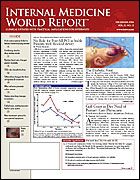Exposure to Environmental Chemicals Affects Male Fertility
NEW ORLEANS—Endocrine disruptors, specifically environmental chemicals, appear to affect sperm quality, based on epidemiologic data suggesting that sperm concentrations are declining over time and that semen quality varies geographically. “These findings have raised the question of environmental exposure,” Russ B. Hauser, MD, MPH, Harvard School of Public Health, said at the American Society of Reproductive Medicine meeting.
Endocrine disruptors are exogenous agents that interfere with the synthesis, secretion, transport, binding, action, or elimination of the natural hormones in the body that are responsible for maintaining homeostasis, reproduction, development, and/or behavior.
The chemicals of concern include (1) industrial chemicals, especially polychlorinated biphenyls (PCBs) and dioxin (a product of combustion and a component of Agent Orange); (2) pesticides, in particular, the persistent pesticides DDT and its metabolite DDE (which has a half-life exceeding a decade), and nonpersistent pesticides, such as organophosphates (contained in roach and ant killer) and pyrethroids (which are replacing the organophosphates that have shown to have neurodevelopmental effects in children); and (3) chemicals in consumer products, such as phthalates and bisphenol A, an estrogenic compound used in the lining of cans.
Most is known about PCBs, which were widely used for decades. Despite being banned in the United States in 1977, exposure still occurs through the diet.
In accidents in Japan and Taiwan, high levels of exposure to PCBs were associated with poorer sperm morphology, lower sperm counts, and reduced motility. Other studies have found an inverse association between PCBs and sperm motility “at general background environmental exposure levels,” Dr Hauser said.
Phthalates are currently ubiquitous in the environment and are the focus of Dr Hauser’s research. In laboratory animals, phthalates proved to be developmental and reproductive toxicants, producing alterations in testicular function and semen quality.
“The concern for humans is that exposure is widespread on a population level,” he said.
Phthalates are widely found in medical devices (including IV tubing), processing and packaging material, building products (eg, PVC pipes), and even toys. Phthalates are also used to coat some medications.
Epidemiology
Dr Hauser and colleagues examined the effect of phthalates on sperm quality in 168 American men (mean age, 35 years) from an infertility clinic (. 2003;14:269-277). A second, Swedish study in humans involved military recruits (aged 18-20 years). The findings conflicted.
In the US study, dose-response relationships were found between monobutyl and monobenzyl phthalates and ≥1 semen parameters, and a relationship was suggested between monomethyl phthalate and sperm morphology. These findings were then confirmed and expanded in a follow-up study (in press). “In infertile men exposed to phthalates at levels in the general population, we found increased odds of having below-reference sperm concentration and motility,” Dr Hauser reported.
The Swedish investigators, however, found no evidence indicating that the infertile population is more susceptible than men from the general population, he said.
Dr Hauser suggested avoiding fish known to have high levels of mercury, including tuna, swordfish, king mackerel, and shark. Organic produce is less likely to contain organophosphate, although he noted that a reduction in health risk has not been proven.
“These chemicals are all out there—mercury, PCBs, phthalates. Decisions about which fish we eat, and which products we use, can lead to lower exposure in individuals,” he stated. “The question becomes, at what dose do you start to see population effects?”
Much remains unknown about the reproductive risks associated with the 80,000 chemicals used in commerce, even such widely used ones as bisphenol A, nonylphenol, and the pyrethroids, he said.
